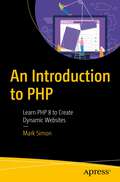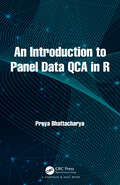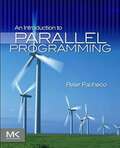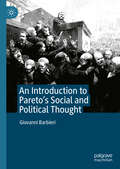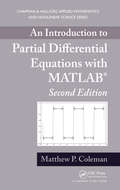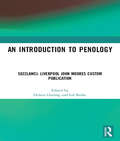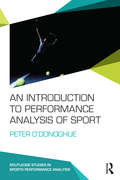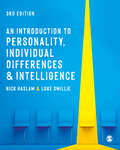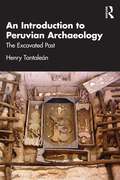- Table View
- List View
An Introduction to PHP for Scientists and Engineers: Beyond JavaScript
by David R. BrooksThis book provides an introduction to PHP and server-side programming. It presents readers with a science or engineering background with the information to write their own online applications requiring reading, creating and manipulating data files stored as text on a server, overcoming the limitations of a client-side language. It focuses only on those elements of the language, such as file input/output, arrays, built-in math functions, and user-created functions that are essential for solving a wide range of scientific/engineering computing problems - and assumes a working knowledge of programming concepts and HTML, JavaScript, C or a similar language. It contains complete applications and hence offers a very compact and efficient way for working professionals to take advantage of the possibilities offered by server-side programming. Written for a technical audience, this book is an effective learning tool to the essentials of PHP and is also ideal for self-study.
An Introduction to PHP: Learn PHP 8 to Create Dynamic Websites
by Mark SimonUse PHP to enhance your web pages. This book shows you how PHP programming works, and how to write and organize PHP code. The book starts with steps to download and install a setup for a sample website that will form the basis for upcoming chapters. You start by writing PHP code and learn how to mix it with HTML and manage the code. From there, you will learn about dynamic content, along with a deep dive into form processing and sending email. Saving uploaded data and uploading files is discussed next. You will learn how to configure your PHP project and develop a library. You will then learn how to create an image catalog and manage data on your web page. By the end of the book, you will understand how to work with cookies, sessions, and logging in, followed by an example of creating a simple blog that reiterates the concepts developed in the previous chapters.After reading this book, you will be able to configure, create, and manage your dynamic website.What Will You LearnKnow the basics of programming with the PHP languageUse PHP to generate dynamic web pagesWork with SQL databasesWork with forms to upload text data and binary filesUse tips and tricks to write clean and maintainable codeWho This Book Is ForWeb developers and students learning to develop and maintain PHP code on their website
An Introduction to Pablo González Casanova: Intellectual of the Dignified Rebelliousness (Classic and Contemporary Latin American Social Theory)
by Jaime Torres Guillén Jaime Antonio Preciado CoronadoThis book is an introduction to Pablo González Casanova, giant of Latin American sociology. It examines his work across history, sociology, political science, and anthropology, exploring in depth his writings on the university, democracy, the new sciences, alternatives to capitalism, the humanities, equity with social justice, patriarchal domination, and the struggle for planet earth. This book provides insights into a foundational Latin American perspective on global realities. It argues that Pablo González Casanova contributes original elements for the construction of a critical theory in the social sciences and humanities of Mexico, Latin America, and the Caribbean. With an enriching interdisciplinary perspective, this book will be of interest to scholars from a range of specialized interests in sociology, political science, philosophy, anthropology, cultural studies, scientific epistemology, methodology, and critical thinking in the alternative field to capitalism.
An Introduction to Panel Data QCA in R
by Preya BhattacharyaIn the last few years, Qualitative Comparative Analysis (QCA) has become one of the most important research approaches in social science. This has encouraged researchers to apply QCA, to analyze cross-sectional and panel data, leading to the development of a variety of cross-sectional and panel data QCA models.This book compares four different panel data QCA models: Cluster QCA, Multiple Sub-QCA, Remote-Proximate Panel, and Relevant Variation Panel. It starts by introducing QCA as a research approach, then discusses the assumptions, and steps in a QCA research process. It then applies these assumptions and steps to demonstrate each of the 4 afore-mentioned panel data QCA models. Each chapter also provides a step-by-step guide, that researchers can follow while building any of these 4 panel data QCA models. Finally, it compares the strengths and weaknesses of each of these models and suggests scenarios where researchers can apply them. This book is supplemented by materials like datasets and codes, available at the end of each chapter, and online on Harvard Dataverse. This book can be used as a textbook for introductory and advanced courses on panel data QCA.
An Introduction to Parallel Programming
by Peter PachecoAn Introduction to Parallel Programming by Pacheco, Peter
An Introduction to Pareto's Social and Political Thought
by Giovanni BarbieriThis book analyses Pareto&’s social and political thought a hundred years after his death, showing how the structure of the scholar&’s works is generally quite clear (contrary to what is commonly presumed), and how the maintenance of the social and political systems&’ equilibrium represents Pareto&’s main research focus . In particular, the aim of this book is to demonstrate how the author considers the &‘right middle path&’ – in the social, economic, and political arenas – as the only way capable of ensuring social cohesion. The book will be of interest to scholars and researchers of sociology, sociological and political theory, and political science.
An Introduction to Partial Differential Equations
by Yehuda Pinchover Jacob RubinsteinA complete introduction to partial differential equations. A textbook aimed at students of mathematics, physics and engineering.
An Introduction to Partial Differential Equations (Synthesis Lectures On Mathematics And Statistics Series)
by Daniel ArrigoThis textbook is an introduction to the methods needed to solve partial differential equations (PDEs). Readers are introduced to PDEs that come from a variety of fields in engineering and the natural sciences. The chapters include the following topics: First Order PDEs, Second Order PDEs, Fourier Series, Separation of Variables, the Fourier Transform, and higher dimensional problems. Readers are guided through these chapters where techniques for solving first and second order PDEs are introduced. Each chapter ends with series of exercises to facilitate learning as well as illustrate the material presented in each chapter.
An Introduction to Partial Differential Equations with MATLAB (Advances in Applied Mathematics)
by Matthew P. ColemanAn Introduction to Partial Differential Equations with MATLAB, Second Edition illustrates the usefulness of PDEs through numerous applications and helps students appreciate the beauty of the underlying mathematics. Updated throughout, this second edition of a bestseller shows students how PDEs can model diverse problems, including the flow of heat,
An Introduction to Partial Differential Equations with MATLAB (ISSN #27)
by Matthew P. Coleman Vladislav BukshtynovThe first two editions of An Introduction to Partial Differential Equations with MATLAB® gained popularity among instructors and students at various universities throughout the world. Plain mathematical language is used in a friendly manner to provide a basic introduction to partial differential equations (PDEs).Suitable for a one- or two-semester introduction to PDEs and Fourier series, the book strives to provide physical, mathematical, and historical motivation for each topic. Equations are studied based on method of solution, rather than on type of equation.This third edition of this popular textbook updates the structure of the book by increasing the role of the computational portion, compared to previous editions. The redesigned content will be extremely useful for students of mathematics, physics, and engineering who would like to focus on the practical aspects of the study of PDEs, without sacrificing mathematical rigor. The authors have maintained flexibility in the order of topics.In addition, students will be able to use what they have learned in some later courses (for example, courses in numerical analysis, optimization, and PDE-based programming). Included in this new edition is a substantial amount of material on reviewing computational methods for solving ODEs (symbolically and numerically), visualizing solutions of PDEs, using MATLAB®'s symbolic programming toolbox, and applying various schemes from numerical analysis, along with suggestions for topics of course projects.Students will use sample MATLAB® or Python codes available online for their practical experiments and for completing computational lab assignments and course projects.
An Introduction to Passive House
by Justin BereThroughout the world, Passive House is now recognised as the best method to create comfortable, healthy, low energy buildings and it is a key component of the 21st century's green economic revolution. Written by one of the UK's leading passive house architects, this book contains essays that reveal the technical and creative secrets of Passive House design, as well as containing case studies of some of the world's best examples of beautiful, technically excellent buildings that still feel great even when the power supply is turned down to almost nothing. Whether you are an architect, client, student or construction professional, this book is an enlightening introduction to Passive House and a valuable source of inspiration.
An Introduction to Pattern Recognition and Machine Learning
by Paul FieguthThe domains of Pattern Recognition and Machine Learning have experienced exceptional interest and growth, however the overwhelming number of methods and applications can make the fields seem bewildering. This text offers an accessible and conceptually rich introduction, a solid mathematical development emphasizing simplicity and intuition. Students beginning to explore pattern recognition do not need a suite of mathematically advanced methods or complicated computational libraries to understand and appreciate pattern recognition; rather the fundamental concepts and insights, eminently teachable at the undergraduate level, motivate this text. This book provides methods of analysis that the reader can realistically undertake on their own, supported by real-world examples, case-studies, and worked numerical / computational studies.
An Introduction to Penology - LJMU Custom Publication: Essential Reading (level 5)
by Helena Gosling; Lol BurkeThis book encourages criminology students to critically engage with both longstanding and emerging penological debates, taking into consideration the theory, policy and practice which surrounds both custodial and community interventions.
An Introduction to Penology: Punishment, Prisons and Probation
by Lawrence Burke Helena goslingAn Introduction to Penology is a concise, informative, scholarly guide that will speak to a variety of audiences interested in how the notion of punishment plays out in community and custodial settings with people who have broken the law. With a particular focus on prisons and probation, the book provides an opportunity for readers to critically engage with the concept of punishment (in theory and practice) and consider different ways in which we, as a society, can respond to lawbreaking. The text will allow students to pursue a more in-depth study of two of the main criminal justice institutions through the lens of their organisational structures, cultures, service delivery and responses to the needs of minority and vulnerable groups. Throughout the text, students will be encouraged to critically engage with longstanding penological debates taking into consideration the theory, policy and practice of punishment, and will explore ways in which we can rethink penology on an individual and social level and begin to make a case for social justice rather than criminal justice. This innovative and contemporary text is a must read for students studying criminology, criminal justice, penology and those interested in pursuing a career in either the prison or probation services. Lol Burke is Professor in Criminal Justice and Dr Helena Gosling is a Senior Lecturer in Criminal Justice at Liverpool John Moores University.
An Introduction to Penology: Punishment, Prisons and Probation
by Lawrence Burke Helena goslingAn Introduction to Penology is a concise, informative, scholarly guide that will speak to a variety of audiences interested in how the notion of punishment plays out in community and custodial settings with people who have broken the law. With a particular focus on prisons and probation, the book provides an opportunity for readers to critically engage with the concept of punishment (in theory and practice) and consider different ways in which we, as a society, can respond to lawbreaking. The text will allow students to pursue a more in-depth study of two of the main criminal justice institutions through the lens of their organisational structures, cultures, service delivery and responses to the needs of minority and vulnerable groups. Throughout the text, students will be encouraged to critically engage with longstanding penological debates taking into consideration the theory, policy and practice of punishment, and will explore ways in which we can rethink penology on an individual and social level and begin to make a case for social justice rather than criminal justice. This innovative and contemporary text is a must read for students studying criminology, criminal justice, penology and those interested in pursuing a career in either the prison or probation services. Lol Burke is Professor in Criminal Justice and Dr Helena Gosling is a Senior Lecturer in Criminal Justice at Liverpool John Moores University.
An Introduction to Pentecostalism
by Allan Heaton AndersonPentecostalism has become the fastest growing Christian movement, particularly outside Europe, and Allan Heaton Anderson is one of the foremost scholars of this phenomenon. His innovative interpretation of Pentecostalism focuses on the serious contribution made by both western and Majority World participants in its development. In this second edition of his leading introductory course book, Anderson presents an updated global history of the movement, which addresses significant events and changes in recent years, and surveys important theoretical issues such as gender and society, as well as politics and economics. The book also offers a comprehensive explanation of the significance of Charismatic Christianity throughout the world, plus its effect upon the globalisation of religion and its transformation in the present century. This new edition will be an important resource for those studying Pentecostalism, Charismatic Christianity, theology and sociology of religion.
An Introduction to Performance Analysis of Sport (Routledge Studies in Sports Performance Analysis #6)
by Peter O'DonoghuePerformance analysis has become an essential tool for coaches, athletes, sports organisations and academic researchers. Collecting and interpreting performance data enables coaches to improve their training programmes, athletes to make better tactical decisions, sports organisations to manage teams more effectively, and researchers to develop a better understanding of sports performance. This book is an essential introduction to the fundamental principles of performance analysis of sport and how to develop and operate performance analysis systems. Containing worked examples from real sporting events throughout, the book introduces the basics of quantitative and qualitative performance analysis, reviews the different types of data and information that performance analysis can generate, and explains how to test for reliability. It presents a step-by-step guide to developing both manual and computerised analysis systems, and writing up and presenting findings from performance analysis programmes. Representing the most up-to-date, concise and engaging introduction to sports performance analysis, this book is an ideal course text for all introductory performance analysis courses, as well as an invaluable primer for coaches and practitioners in sport.
An Introduction to Performance Analysis of Sport (Routledge Studies in Sports Performance Analysis)
by Peter O'Donoghue Adam Cullinane Gemma DaviesPerformance analysis has become an essential tool for coaches, athletes, sports organisations and academic researchers. Collecting and interpreting performance data enables coaches to improve their training programmes, athletes to make better tactical decisions, sports organisations to manage teams more effectively and researchers to develop a better understanding of sports performance. This fully revised new edition is an essential introduction to the fundamental principles of performance analysis of sport and how to develop and operate performance analysis systems.Containing worked examples from real sporting events as well as new content examining innovations in determining what to analyse, advances in feedback technology, performance profiles, principles for delivering feedback and telestration within video sequences, An Introduction to Performance Analysis of Sport reviews the different types of data and information that performance analysis can generate and explains how to test for reliability.This cutting-edge book presents a step-by-step guide to developing both manual and computerised analysis systems and writing up and presenting findings from performance analysis programmes. Representing the most up-to-date, concise and engaging introduction to sports performance analysis, this book is an ideal course text for all introductory performance analysis courses, as well as an invaluable primer for coaches and practitioners in sport.
An Introduction to Personality Study (Psychology Library Editions: Personality #4)
by Raymond B. CattellOriginally published in 1950, the need for a small standard text on basic principles of personality structure and development had been very apparent to teachers of psychology for some time. There were many books illustrating specialized or applied aspects of the psychology of personality – such as abnormal psychology, educational psychology, child psychology, mental measurement, vocational guidance, etc. – but lacking was a treatment of personality study as pure psychology, concentrating on the fundamentals. The aim of this title was therefore to bring the general problems of personality description and development, normal and abnormal, into a single perspective and to integrate the principle fields of observation in clear cut generalizations.
An Introduction to Personality, Individual Differences and Intelligence (SAGE Foundations of Psychology series)
by Nick Haslam Dr John Song Dr Luke SmillieThe second edition of this popular textbook builds on the strengths of the first, continuing its reputation for clarity, accessibility, conceptual sophistication and panoramic coverage of personality and intelligence. The authorship team is enriched by the addition of two high-profile international scholars, Luke Smillie and John Song, whose expertise broadens and deepens the text. New to this edition: Chapters exploring the neurobiological, genetic and evolutionary foundations of personality; and emotion, motivation and personality processes An enhanced coverage of personality disorders A thoroughly revised and extended section on intelligence which now addresses cognitive abilities and their biological bases; the role of intelligence in everyday life; and emotional intelligence A brand new companion website that includes a substantial test bank and lecture slides. An Introduction to Personality, Individual Differences and Intelligence, Second Edition is a key textbook for all psychology students on a personality or individual differences course.
An Introduction to Personality, Individual Differences and Intelligence (SAGE Foundations of Psychology series)
by Nick Haslam Dr John Song Dr Luke SmillieThe second edition of this popular textbook builds on the strengths of the first, continuing its reputation for clarity, accessibility, conceptual sophistication and panoramic coverage of personality and intelligence. The authorship team is enriched by the addition of two high-profile international scholars, Luke Smillie and John Song, whose expertise broadens and deepens the text. New to this edition: Chapters exploring the neurobiological, genetic and evolutionary foundations of personality; and emotion, motivation and personality processes An enhanced coverage of personality disorders A thoroughly revised and extended section on intelligence which now addresses cognitive abilities and their biological bases; the role of intelligence in everyday life; and emotional intelligence A brand new companion website that includes a substantial test bank and lecture slides. An Introduction to Personality, Individual Differences and Intelligence, Second Edition is a key textbook for all psychology students on a personality or individual differences course.
An Introduction to Personality, Individual Differences and Intelligence (SAGE Foundations of Psychology series)
by Nick Haslam Luke SmillieWhat does it mean to have a personality? Is emotional intelligence a kind of intelligence? Learn the answers to these questions, as well as everything you need to know about personality, intelligence, and individual differences in the third edition of this clear and accessible textbook. From natural selection to intelligence tests, and from personality disorders to the concept of IQ, the panoramic coverage of this field makes this textbook essential reading for any psychology student on a personality and individual differences course. New to this edition: · Increased coverage of intelligence · ‘Key Theorists’ feature · Discussion questions moved to end-of-chapter to enable in-text assessment Nick Haslam is Professor of Psychology at the University of Melbourne, Australia. Luke Smillie is an Associate Professor of Psychology at the University of Melbourne and director of the Personality Processes Lab.
An Introduction to Personality, Individual Differences and Intelligence (SAGE Foundations of Psychology series)
by Nick Haslam Luke SmillieWhat does it mean to have a personality? Is emotional intelligence a kind of intelligence? Learn the answers to these questions, as well as everything you need to know about personality, intelligence, and individual differences in the third edition of this clear and accessible textbook. From natural selection to intelligence tests, and from personality disorders to the concept of IQ, the panoramic coverage of this field makes this textbook essential reading for any psychology student on a personality and individual differences course. New to this edition: · Increased coverage of intelligence · ‘Key Theorists’ feature · Discussion questions moved to end-of-chapter to enable in-text assessment Nick Haslam is Professor of Psychology at the University of Melbourne, Australia. Luke Smillie is an Associate Professor of Psychology at the University of Melbourne and director of the Personality Processes Lab.
An Introduction to Peruvian Archaeology: The Excavated Past
by Henry TantaleanAn Introduction to Peruvian Archaeology: The Excavated Past offers an accessible and up-to-date guide to Peru’s rich archaeological heritage.Through a broad vision of archaeology as a discipline and historical reality, Henry Tantaleán offers a fascinating immersion into the past of Peru. This book is structured in three parts: an introduction to the key concepts of global and local archaeology, a brief history of Peruvian archaeology, and a tour of the societies of ancient Peru, from the first settlers to the fall of the Inca Empire. Furthermore, the author highlights the role of archaeology in daily life, education, and popular culture.This book is an invaluable resource not only for students and professionals of Peruvian archaeology but also for anyone interested in understanding the cultural legacy that these findings contribute to our understanding of human history.
An Introduction to Pet Dental Care: For Veterinary Nurses and Technicians
by Kathy IstacePeriodontal disease is one of the most common diseases observed by small animal practitioners, and it is not uncommon for the veterinary technician to be the first line in oral health assessment and treatment. Despite this, current dentistry training for veterinary technicians and nurses is often very limited. This book explains the causes, consequences, prevention and treatment of pet dental diseases including periodontal disease, fractured teeth, tooth resorption, dental malocclusions, oral masses, jaw fractures, and other oral conditions. It covers: · Instruction in essential skills such as dental cleaning, charting, radiography, and equipment maintenance. · Advanced skills such as the administration of regional nerve blocks and periodontal treatments. · The aetiology and treatment of common oral conditions. Improving competence in veterinary dental skills benefits technicians, veterinary practices, owners and their pets. Explaining pet dental diseases in a relatable way, this book allows veterinary staff to relay important dental information to pet owners in a way they understand. Providing solutions to help prevent and manage pet dental diseases, it outlines treatment options, outcomes, and post-operative dental care.

